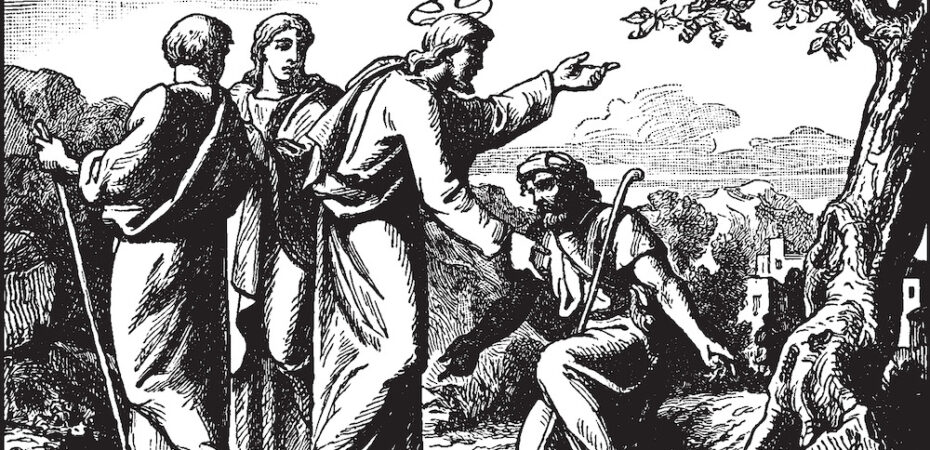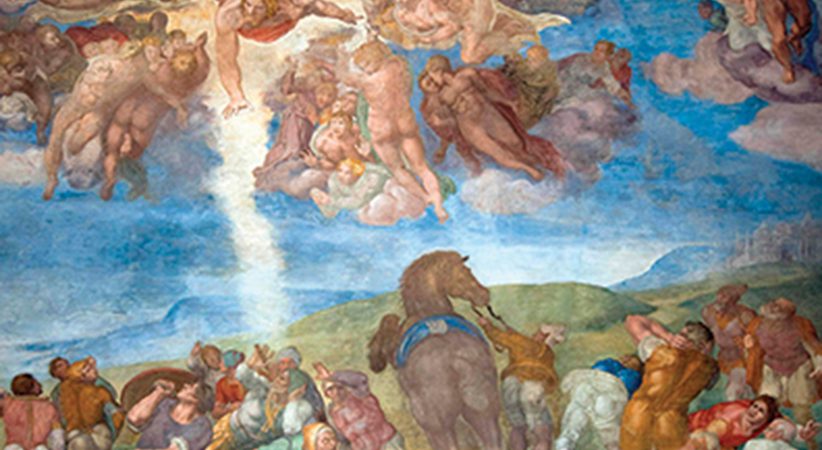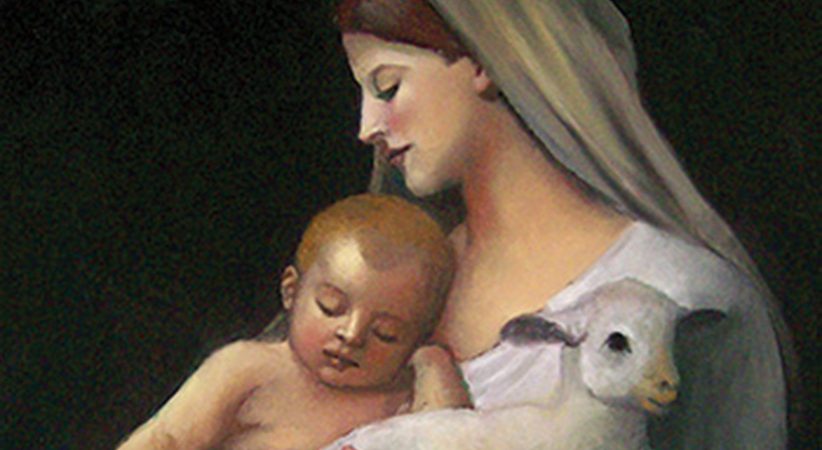Journey of Gratitude
A daily practice that reflects appreciation deepens our relationship with God
Patricia Sharbaugh Comments Off on Journey of Gratitude
I went to see a play many years ago. I don’t recall the name of the play or much of its plot, but one scene remains etched in my memory. A young gentile man has fallen in love with a Jewish woman, and she takes him home to meet her parents on Passover. He doesn’t understand anything about the Passover dinner they are celebrating and is awkwardly trying, and failing, to please her parents.
At one point during the meal, the father reads a series of statements praising God for all of God’s great deeds for the people of Israel. The family follows along, mechanically responding with ritual statements of praise, but the young man, never having heard the story before, moves past his awkwardness and gets completely swept up in the story of God’s salvation. Unable to contain his wonder at all God has done, he forgets himself and exclaims, “Wow! God did all of that!”
The Samaritan leper who returns to thank Jesus for healing him reminds me of the young man in the play.
Crossing Boundaries
Luke’s story about the thankful Samaritan (cf. 17:11-19) begins with a sentence that reminds us that Jesus is on a journey to Jerusalem, where he will face his death. Luke tells us that Jesus is passing between Samaria and Galilee. This vague and ambiguous geographic reference alerts the reader to two important aspects of this story. One, the story involves a Samaritan and, therefore, one of crossing boundaries. Two, it takes place in a liminal space, a place of transition, a place where neither Galileans nor Samaritans feel completely at home. Though Jesus’ destination is clear — death in Jerusalem — he continues to heal, save and teach as he journeys there. Jesus’ journey through a liminal space teaches Gospel readers lessons about finding salvation along the way as we listen in all the places of life that do not feel like home.
The tension-filled boundary between Jews and Samaritans is rooted in their complex interwoven history. At some point, the term Samaritan came to designate not merely Jews who lived in the region of Samaria, but a group of people who practice a distinctive form of Yahwism. Growing animosity between Jews and Samaritans is expressed in the description of Samaritans in 2 Kings 17, which claims that following the Assyrian invasion of the northern kingdom in 722-721 B.C., the Samaritans intermarried with foreign conquering nations, set up shrines and worshipped foreign gods. Historians universally agree that the description in 2 Kings is false, and yet, this maligning of the Samaritans continues to be taught and repeated.
……………………………………………………………………………………………………………………………………………
In Thanksgiving
Father all-powerful, your gifts of love are countless and your goodness infinite; as we come before you on Thanksgiving Day with gratitude for your kindness, open our hearts to have concern for every man, woman and child, so that we may share your gifts in loving service. — From the Collect on Thanksgiving Day
…………………………………………………………………………………………………………………………………………….
In fact, the Samaritan religion as it was known during the Roman Empire was a very strict form of Yahwism that is less syncretistic than Judaism. Samaritans accepted only the Pentateuch as Holy Scripture, believing that Mount Gerizim in Samaria rather than Mount Zion in Jerusalem was the place God had designated for sacrifice and worship, and did not observe the same laws of clean and unclean that other Jews did. These differences in faith practices resulted in deep distrust and animosity between Jews and Samaritans and created a boundary between them that was difficult to cross.
The story of the grateful Samaritan highlights a second equally powerful boundary, the boundary between those who were healthy and those who suffered from the disease of leprosy. Understanding leprosy and its effects on the lives of those afflicted with this disease is vital for understanding this story.
People today associate leprosy with Hansen’s disease. It is debated if Hansen’s disease even existed in ancient Israel, and this is not the disease that is meant when the word leprosy is invoked by the biblical writers. Instead, leprosy is used to designate various skin conditions such as psoriasis, lupus, ringworm and favus. What Luke tells us about the 10 lepers that cry out to Jesus corresponds with what we know about lepers in ancient Israel. They were expected to stay isolated from those who were healthy. They formed their own colonies and often positioned themselves along travel routes so that they could appeal to travelers for charity. If healed of leprosy, one was expected to show himself to a priest so that the priest could authenticate the cleansing and declare the formerly infected clean.
The Samaritan in this story is not at home in the world. Like his community of fellow lepers, he is isolated from others because of his illness. His isolation is greater than the others, however, because he is a Samaritan, and the other Jews he is with hold Samaritans in contempt. In this story, Jesus refers to him as a foreigner, showing that Jesus identifies with Jews rather than Samaritans, and yet this marginalized Samaritan teaches us about the power of gratitude.
Echoes of Gratitude
Gratitude lies at the heart of our Thanksgiving holiday. The Thanksgiving holiday we celebrate today traces its origins to the pilgrim celebration of the first harvest in the New World in 1621. The 53 pilgrims who attended the three-day feast had endured a miserable transition. One hundred and two pilgrims began the journey to the new world on the Mayflower. Crossing of the Atlantic and the harsh winter that followed killed almost half of these pilgrims. Despite this profound suffering, the pilgrims saw the harvest of new food as a reason to celebrate and in that liminal space of transition to a new country invited the Native Americans, who had offered vital assistance to the pilgrims during their first grueling winter, to attend the celebration. Ninety Wampanoag people attended the feast.
The echo of gratitude expressed by the pilgrims and Natives continues to reverberate in our American holiday. Thanksgiving remains relatively simple and less materialistic than many other national holidays. Most people celebrate at home with family and friends, gratitude remains at the heart of the feast, and making sure that those without family to celebrate are invited is a high priority for many. Perhaps a holiday that has gratitude at its heart is one that is not easily corrupted by greed and ambition. Gratitude is an echo of grace, an awakening, an opening of the heart, a way of seeing.
A Way to See
Two moments of seeing are highlighted in the story of the thankful Samaritan. Jesus sees (ίδών) the lepers who cry out to him (cf. Lk 17:13) and the Samaritan sees (ίδών) that he is healed (v. 15). In both verses, seeing propels the action. Upon seeing the lepers, Jesus instructs them to go show themselves to the priests. Upon seeing he was healed, the Samaritan praises God with a loud voice, falls at the feet of Jesus and gives thanks. It is interesting that the lepers in this story do not have evidence of their healing before they set out to show themselves to the priests.
Following Jesus’ instructions is an act of faith. When the Samaritan sees that he is healed, that seeing is an awakening to a deeper perception of the faith required to begin his journey to the priests. His seeing involves recognizing Jesus as the source of his healing and the place to give glory to God. Rather than go to the Temple, the synagogue or to simply continue on his way to see the priests, he turns back toward Jesus and falls at his feet.
The deeper seeing of the Samaritan that results in his actions of return and praise elicits three questions from Jesus, all highlighting missing expressions of gratitude from nine of the ten healed lepers. Jesus’ concern with this lack of gratitude is not rooted in his need to be thanked. Rather his declaration to the Samaritan, “Your faith has saved you” (Lk 17:19), draws attention to the power of gratitude. The Samaritan’s gratitude led him to see Jesus as the source of healing and the presence of God. The Samaritan’s gratitude awakened him to see in his moment of personal healing a participation in the wider salvation of God. Without gratitude, the nine other lepers were healed. Their lives were improved but not fully transformed by the power of God.
The Power of Gratitude
The power of gratitude lies in its ability to open our hearts to receive our lives as gift. The gentile man celebrating a Passover meal for the first time, the pilgrims experiencing their first harvest in a new world, and the healed Samaritan leper show us that it is often strangers, those not completely at home in the world, those who have endured a rough journey, who feel most forcefully the transformative power of gratitude. Journeys, boundary crossings, transitions and suffering shake us loose from the routine familiarity we allow to dull our senses to the mystery of God’s presence in our lives. When we allow familiarity to dull our senses in this way, we become like the nine ungrateful lepers who have a profound experience of the healing power of God but fail to notice its significance.
Practicing gratitude is a way to cleanse the dulled-over lenses of our hearts so that we can see more clearly and experience God’s presence in our lives more deeply. When we practice gratitude, we become observers of our lives. Observing provides a small inner space of separation between experience and meaning that allows us to see more clearly God’s presence in many small moments of blessing that might go unnoticed without gratitude. Naming our blessings as we do on Thanksgiving Day is a way to awaken our hearts to God’s goodness permeating our lives.
The story of the thankful Samaritan might inspire us to supplement our yearly Thanksgiving practice by extending gratitude to the small blessings of everyday life. We might begin each day with a prayer of thanksgiving for the gift God has given us of a brand-new day. We might allow the beauty of a sunrise or sunset to stir us into praise. We might thank God daily for the gift of health, nutritious food, loving family and supportive friends. We might more readily notice a kind word, a peaceful moment, small expressions of love, the gift of someone’s trust in us. Small consistent ways of practicing gratitude nurture spacious hearts within us that continually deepen appreciation of the mystery of God’s presence in our lives. In time, our daily gratitude practice deepens our relationship with God so profoundly that we find ourselves seeing the presence of God not only in the beautiful, good, enjoyable aspects of life, but even in life’s challenges. Gratitude has the power to awaken us to the wonder in every step of our journey.
As we journey through our lives, inevitably we will pass through times of transition, liminal spaces where we do not feel at home, times of suffering and times of harvest, and through it all gratitude keeps us focused on God as the source of our lives, the source of our healing and the reason for our hope.
PATRICIA SHARBAUGH, Ph.D., is associate professor of theology at Saint Vincent College in Latrobe, Pennsylvania. She specializes in the field of biblical theology.





